Click on images to enlarge
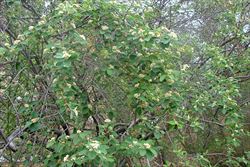
habit in flower (Photo: Sheldon Navie)
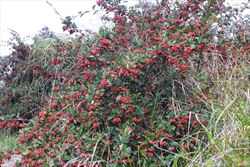
habit in fruit (Photo: Trevor James)
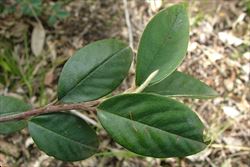
leaves (Photo: Sheldon Navie)
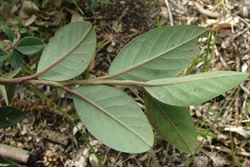
undersides of younger leaves (Photo: Sheldon Navie)
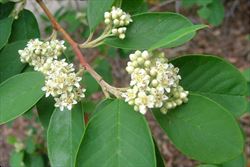
dense flower clusters (Photo: Sheldon Navie)
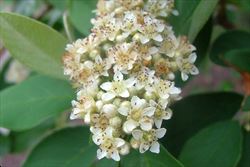
flowers (Photo: Sheldon Navie)
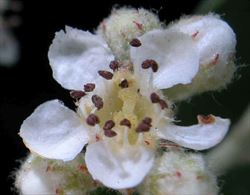
close-up of flower (Photo: Greg Jordan)

older leaves, with hairless undersides, and mature fruit (Photo: Rob and Fiona Richardson)
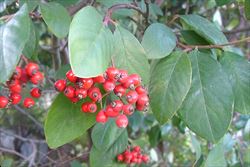
mature fruit (Photo: Sheldon Navie)
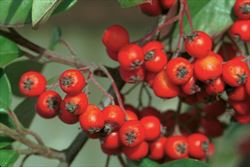
close-up of mature fruit (Photo: Rob and Fiona Richardson)
Scientific Name
Cotoneaster glaucophyllus Franch.
Synonyms
Cotoneaster glaucophyllus Franch. forma serotinus (Hutch.) StapfCotoneaster glaucophyllus Franch. var. serotinus (Hutch.) L.T. Lu & A.R. BrachCotoneaster serotinus Hutch.
Family
Malaceae (New South Wales)Rosaceae (Queensland, the ACT, Victoria, Tasmania, South Australia and Western Australia)
Common Names
bright bead cotoneaster, cotoneaster, grey cotoneaster, grey leaf cotoneaster, grey leafed cotoneaster, greyleaf cotoneaster, grey-leaved cotoneaster, large leaf cotoneaster, large-leaf cotoneaster, large-leaved cotoneaster
Origin
This species originated in eastern Asia (i.e. in southern China and Vietnam).
Cultivation
A common garden plant (i.e. ornamental), particularly in southern Australia.
Naturalised Distribution
Naturalised around populated areas mainly in the south-eastern parts of the country. It is most common in eastern New South Wales, the ACT, Victoria and Tasmania. Scattered populations are present in south-western Western Australia and in the southern parts of South Australia.
Also naturalised on Lord Howe Island and in New Zealand.
Habitat
A weed of open woodlands, grasslands, coastal environs, urban bushland, waterways, roadsides, railway lines, disturbed sites and waste areas. It is mostly restricted to temperate regions.
Habit
An upright (i.e. erect) or arching, many-stemmed, shrub or small tree usually growing 3-5 m tall, but occasionally reaching up to 7 m in height.
Distinguishing Features
- an upright or arching shrub (usually growing 3-5 m tall) with many branching stems.
- younger branches are reddish-brown and finely hairy, older branches become hairless and turn grey or dark brown.
- its leaves are moderately large (2-8 cm long and 1.5-4.0 cm wide) with smooth and dark green upper surfaces.
- lower leaf surfaces are initially greyish-green and hairy, but they become pale green or bluish-green with age.
- its small white flowers (about 5 mm across) are borne in large dense clusters and have five small spreading petals.
- its rounded or egg-shaped 'berries' (6-8 mm across) turn bright red as they mature.
Stems and Leaves
The stems are upright (i.e. erect) at first and later become arched. Younger branches are reddish-brown in colour and covered in fine downy hairs (i.e. they are pubescent). As they age, the stems become hairless (i.e. glabrous) and turn grey or dark brown in colour.
The alternately arranged leaves are borne on stalks (i.e. petioles) 4-10 mm long. They are oval (i.e. elliptic) or egg-shaped in outline (i.e. ovate) and are widest at or below the middle. The leaf blades (2-8 cm long and 1.5-4 cm wide) have entire margins and pointed tips (i.e. acute apices). Their upper surfaces are smooth and dark green in colour while their lower surfaces are initially greyish-green and covered in whitish hairs (i.e. they are pubescent). These hairs often wear off as the leaves mature, leaving pale green or slightly bluish-green (i.e. glaucous) undersides.
Flowers and Fruit
The white flowers (5-8 mm across) are borne in large clusters along the branches that each contain 20-60 flowers. The individual flowers are borne on short stalks (i.e. pedicels) 2-4 mm long and have five small spreading petals (2-4 mm long). They also have five sepals (1-2 mm long and 1.5-2.5 mm wide), about 20 stamens and two styles. Flowering occurs mostly during late spring and summer.
The rounded (i.e. globular) or egg-shaped (i.e. ovoid) fruit are borne in large hanging clusters. These glossy 'berries' (i.e. pomes) and are initially green, but they turn bright glossy red as they mature. Each 'berry' (6-8 mm across) usually contains two 'seeds' (i.e. nutlets or pyrenes) that are 2-3 mm across. The fruit may be present from autumn through to late winter (i.e. February to August).
Reproduction and Dispersal
This plant reproduces by seed, which are commonly spread by birds that eat the brightly coloured fruit. Seeds are also dispersed by other animals (e.g. foxes) and in dumped garden waste. If plants are cut down they will produce suckers from the base (i.e. crown).
Environmental Impact
Large-leaved cotoneaster (Cotoneaster glaucophyllus ) is a significant environmental weed in Victoria, Tasmania and the ACT, and a moderately important environmental weed in New South Wales, Western Australia and on Lord Howe Island.
This species is commonly found on the fringes of urban bushland and along roadsides in southern Australia. It also invades heathlands, lowland grasslands, open woodlands, dry sclerophyll forests, wet sclerophyll forests, coastal habitats, riparian vegetation, freshwater wetlands and rocky outcrop vegetation. This species, like the other cotoneasters, forms thickets under tall trees and dense infestations will shade out the native ground flora and impede the regeneration of overstorey plants.
Other Impacts
The fruit of large-leaved cotoneaster (Cotoneaster glaucophyllus) are poisonous to humans and this species can also act as a host for bacterial fireblight, a disease of orchards.
Legislation
This species is declared under legislation in the following states and territories:
- ACT: C4 - prohibited pest plant (a pest plant whose propagation and supply is prohibited).
- Western Australia: Unassessed - this species is declared in other states or territories and is prohibited until assessed via a weed risk assessment (throughout the entire state).
Management
For information on the management of this species see the following resources:
- the Randwick City Council Environmental Weed Profile on this species, which is available online at http://www.randwick.nsw.gov.au.
- the Weeds in your Bush section of the Tasmanian Bushcare Toolkit which is available online at http://www.dpiw.tas.gov.au.
- Muyt (2001), Bush Invaders of South-east Australia, pp. 170-171.
Similar Species
Large-leaved cotoneaster (Cotoneaster glaucophyllus) is very similar to grey cotoneaster (Cotoneaster franchetii), silver-leaved cotoneaster (Cotoneaster pannosus), willow-leaved cotoneaster (Cotoneaster salicifolius), milk-flower cotoneaster (Cotoneaster coriaceus) and khasia berry (Cotoneaster simonsii). These species can be distinguished by the following differences:
- large-leaved cotoneaster (Cotoneaster glaucophyllus) has relatively large leaves (20-80 mm long) with upper surfaces that are smooth and dark green in colour. The lower surface of the leaves are initially greyish-green and covered in whitish hairs (i.e. they are pubescent) but these hairs often wear off as the leaves mature, leaving pale green or slightly bluish-green and hairless (i.e. glabrous) undersides. The white flowers have spreading petals and are usually borne in large clusters (usually with 20-60 flowers). Its relatively glossy fruit turn bright red as they mature and usually contain two 'seeds' (i.e. pyrenes).
- grey cotoneaster (Cotoneaster franchetii) has relatively small leaves (20-35 mm long) with greyish-green upper surfaces that are somewhat hairy (i.e. pubescent) when they are young, but become hairless (i.e. glabrous) and shiny in appearance as they mature. The lower surface of the leaves are silvery or whitish in colour and densely hairy (i.e. pubescent). The pink or pinkish-white flowers have relatively upright (i.e. erect) petals and are borne in medium-sized clusters (usually with 5-15 flowers). Its fruit turn orange or pinkish-orange as they mature and usually contain three 'seeds' (i.e. pyrenes).
- silver-leaved cotoneaster (Cotoneaster pannosus) has relatively small leaves (10-40 mm long) with dull greyish-green upper surfaces that are somewhat hairy (i.e. pubescent). The lower surface of the leaves are silvery or whitish and densely hairy (i.e. pubescent). The white flowers have spreading petals and are borne in medium-sized clusters (usually with 6-20 flowers). Its relatively dull and sometimes hairy fruit turn red as they mature and usually contain two 'seeds' (i.e. pyrenes).
- willow-leaved cotoneaster (Cotoneaster salicifolius) has relatively long and narrow leaves (25-90 mm long) with dark green, glossy and hairless (i.e. glabrous) upper surfaces that have prominent veins impressed into them. The lower surface of the leaves are greyish in colour and hairy (i.e. pubescent). The white flowers have spreading petals and are borne in medium-sized clusters. Its fruit turn bright red as they mature and contain two or three 'seeds' (i.e. pyrenes).
- milk-flower cotoneaster (Cotoneaster coriaceus) has relatively large leaves (up to 75 mm long) with shiny dark green and mostly hairless (i.e. glabrous) upper surfaces that have prominent veins impressed into them. The lower surface of the leaves are whitish in colour and densely hairy (i.e. pubescent). The milky white flowers are borne in medium-sized clusters and its fruit turn orange-red or red in colour as they mature.
- khasia berry (Cotoneaster simonsii) has relatively small leaves (about 25 mm long) with bright green upper leaf surfaces that are shiny and have a sparse covering of close-lying (i.e. appressed) hairs. The lower surface of the leaves are greyish-green and also sparsely hairy (i.e. sparsely pubescent). The white or pale pink coloured flowers are borne in small clusters (with only 1-4 flowers). Its shiny fruit turn orange-red or scarlet red in colour as they mature.
Large-leaved cotoneaster (Cotoneaster glaucophyllus) is also relatively similar to the firethorns (Pyracantha spp.) and the hawthorns (Crataegus spp.). However, the firethorns (Pyracantha spp.) have stems that are armed with spines and the hawthorns (Crataegus spp.) have deeply lobed leaves that are also often coarsely toothed (i.e. serrate) towards their tips and stems that are also armed with stout thorns.

